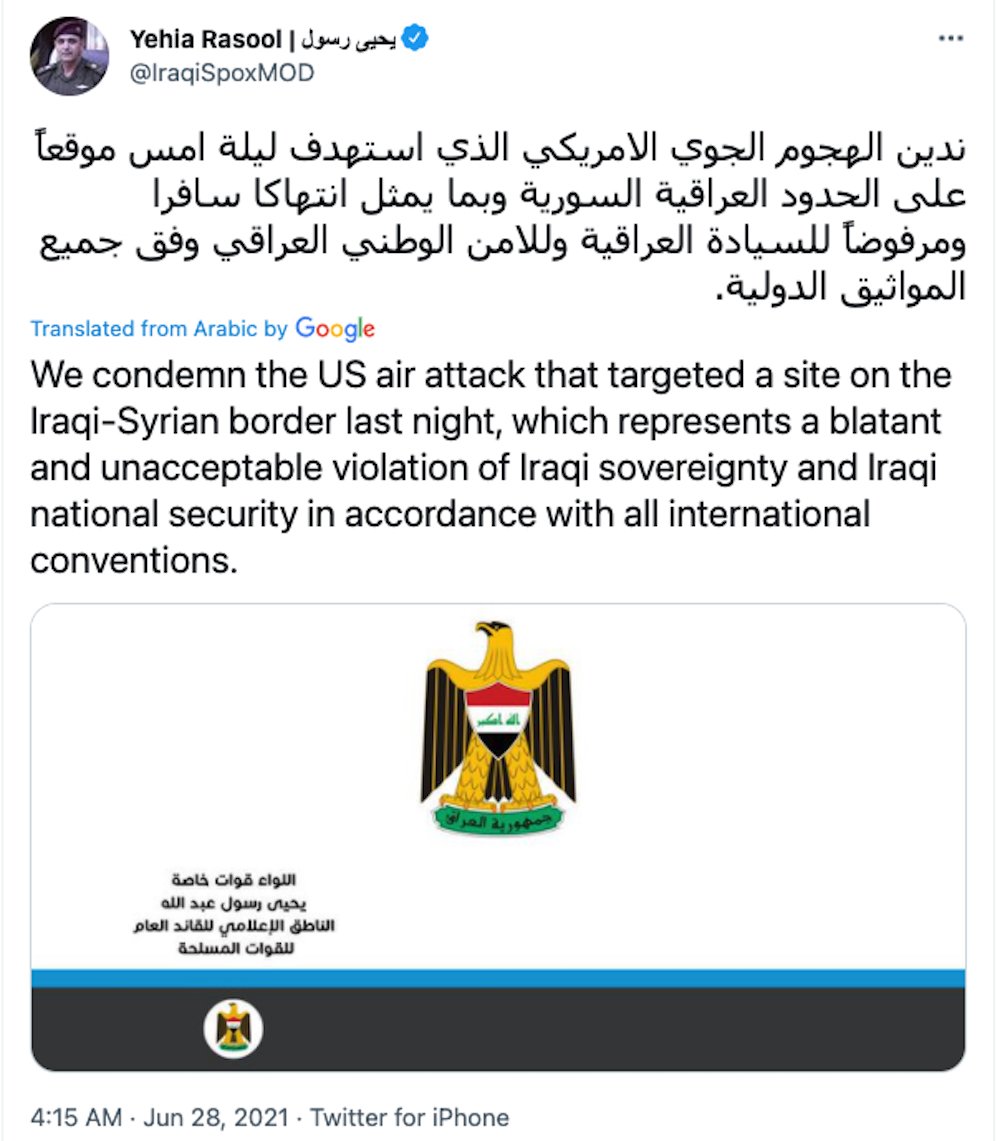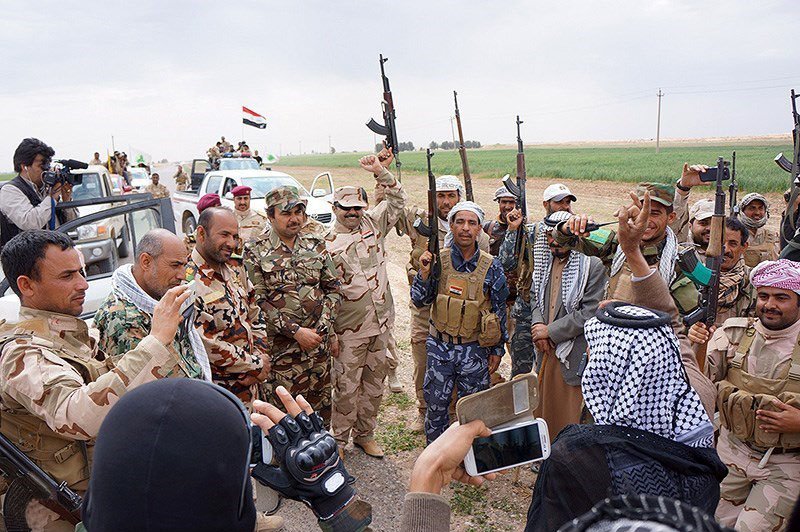Iraqi Popular Mobilization Forces Threaten ‘Open War’ Following US Airstrikes

A US Air Force F-16 Fighting Falcon conducts close-air-support operations over Iraq. US Air Force photo by Staff Sgt. James Harper, courtesy of DVIDS.
The Department of Defense announced Sunday evening that it had launched airstrikes on facilities in the Iraq-Syria border region. The targeted facilities were being used to support drone attacks on US troops, according to the DOD. The strikes targeted two operational and weapons-storage facilities in Syria and one in Iraq, Pentagon press secretary John Kirby said. According to The New York Times, at least four Iraqi Popular Mobilization Force fighters were killed as F-15s and F-16s dropped ordnance on the three locations.
“At President Biden’s direction, U.S. military forces earlier this evening conducted defensive precision airstrikes against facilities used by Iran-backed militia groups in the Iraq-Syria border region,” Kirby said in Sunday’s statement. “The targets were selected because these facilities are utilized by Iran-backed militias that are engaged in unmanned aerial vehicle (UAV) attacks against U.S. personnel and facilities in Iraq.”
U.S has released a video of its airstrikes on #Iran backed militias operating on the Iraqi – Syrian border. The airstrikes targeted the militia’s drone facilities which were used to attack US forces in Iraq. pic.twitter.com/pnZza7CkMV
— IntelOmarion (@IntelOmarion) June 28, 2021
The strikes come as a response to “the ongoing series” of attacks by Iran-backed groups on US interests in Iraq, Kirby said. In April, US personnel in Erbil were the first Americans in Iraq to be targeted by drones. While the Erbil attack caused minimal damage and no American casualties, it has been a cause for concern.
Kirby stated that the airstrikes were intended to disrupt the logistical ability of the Iran-backed groups to prosecute further drone attacks while also deterring the groups from future attacks on Americans.
“The United States took necessary, appropriate, and deliberate action designed to limit the risk of escalation – but also to send a clear and unambiguous deterrent message,” Kirby said.

The Iraqi government condemned the strikes. According to The New York Times, Maj. Gen. Yehia Rasool, a military spokesman for Iraqi Prime Minister Mustafa al-Kadhimi, called the strikes a “blatant and unacceptable violation of Iraqi sovereignty and Iraqi national security.” In April, US and Iraqi government officials completed the fourth round of discussions about America’s continued presence in Iraq. Ultimately, Baghdad and Washington agreed to a complete withdrawal of American combat power from the country, although officials set no timeline.
Rasool also said Sunday that all sides should avoid escalating the situation further and that Iraq “renews its refusal to be a battleground for settling scores, adheres its right to sovereignty over its lands, and to prevent its use as an arena for reactions and attacks,” referring to the country being used as part of a “proxy war” between the US and Iran.
Rasool’s comments come as one of the groups targeted in Sunday’s airstrikes vowed to wage open war against American forces in the country. According to The New York Times, Kata’ib Sayyid al Shuhada released a statement saying, “From now on, we will go to open war with the American occupation, the first action of which is targeting the enemy planes in beloved Iraq’s sky.”

According to Stanford University, the al Shuhada group and Kata’ib Hezbollah, another group targeted Sunday, are part of the Popular Mobilization Forces, formed in 2014 to fight the Islamic State group, or ISIS. Though the Iranian government supported PMF, the Iraqi Parliament made the unit an official part of the Iraqi security state in 2016. This makes the targeting of such groups, despite their ties to Iran, a delicate matter. Additionally, the Popular Mobilization Forces proved instrumental in retaking cities such as Mosul from ISIS.
While Kirby said the US strikes had targeted “operational and weapons facilities,” the Popular Mobilization Forces disagreed, claiming the attacks had targeted personnel rather than equipment. Furthermore, the specific locations of the strikes coincided with locations with concentrations of fighters protecting the Iraqi border from ISIS infiltration.
According to The New York Times, the Popular Mobilization Forces planned to transport the bodies of the fallen to Baghdad for a public burial and expressed condemnation of the attack.
Read Next:

James Webb served as a US Marine infantryman from 2005 to 2010, completing a combat tour in Iraq. He’s worked as a freelance writer and photojournalist covering US troops in Afghanistan, and Webb spent more than two years in the US Senate as a military legislative assistant and as the personal representative of a member on the US Senate Foreign Relations Committee.
BRCC and Bad Moon Print Press team up for an exclusive, limited-edition T-shirt design!
BRCC partners with Team Room Design for an exclusive T-shirt release!
Thirty Seconds Out has partnered with BRCC for an exclusive shirt design invoking the God of Winter.
Lucas O'Hara of Grizzly Forge has teamed up with BRCC for a badass, exclusive Shirt Club T-shirt design featuring his most popular knife and tiomahawk.
Coffee or Die sits down with one of the graphic designers behind Black Rifle Coffee's signature look and vibe.
Biden will award the Medal of Honor to a Vietnam War Army helicopter pilot who risked his life to save a reconnaissance team from almost certain death.
Ever wonder how much Jack Mandaville would f*ck sh*t up if he went back in time? The American Revolution didn't even see him coming.
A nearly 200-year-old West Point time capsule that at first appeared to yield little more than dust contains hidden treasure, the US Military Academy said.












